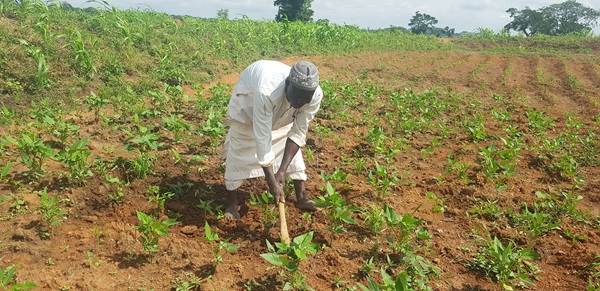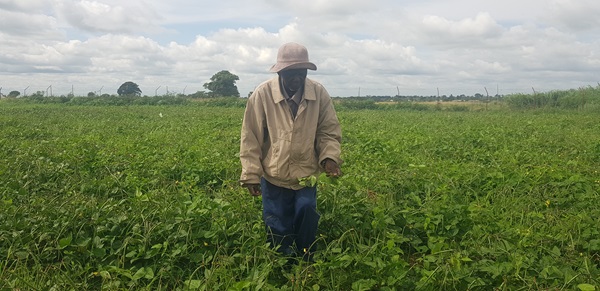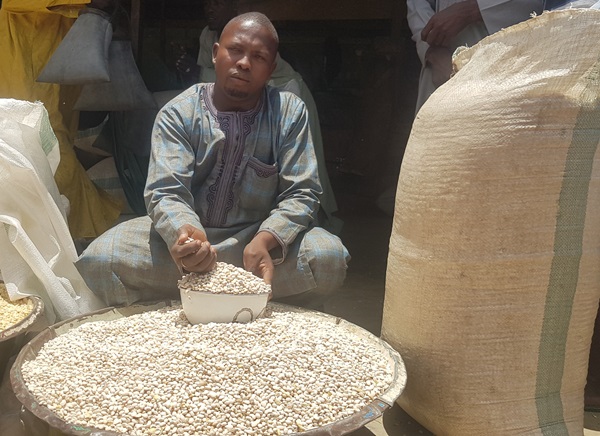
“I used to spray my farm three times a week before the introduction of the Pod Borer Resistant (PBR) Cowpea,” narrated Abubakar Sarki Pada, a 54-year-old cowpea farmer from the outskirts of Dutsen Awba in Zaria local government area, Kaduna State. He lives and farms there with his three wives.
“I spent so much money on insecticides to tackle the Maruca vitrata pests, yet I still had meagre produce from my farm,” he continued.
Pada, who has been planting cowpeas for over 45 years, explained that he was not alone in this predicament; some of his friends sprayed up to 10 times in one season to combat the Maruca menace.
Like Pada and his friends, many Nigerian farmers invested fortunes in purchasing insecticides to ward off Maruca vitrata infestation, striving for even a modest harvest across cowpea-growing regions in Nigeria.
Cowpea, popularly called beans in Nigeria, is consumed daily in most parts of the country. It is an essential food crop, often referred to as the “poor man’s meat” because of its high nutritional value and rich protein content. It is a regular feature on tables in many Nigerian homes. Over time, Nigerians have developed various recipes with beans, including steamed paste (moi moi), deep-fried cake (akara) and porridge. These are just a few examples of its direct consumption uses.
Cowpea is also a significant component of the livestock system, as its fodder is used to feed animals, playing a vital role in the animal industry.
Thus, it is a crop where virtually every part is utilised, whether in human dishes or for animal feed.
Nigeria is the largest producer and consumer of cowpeas in the world. The national average yield is around 750 kg/ha, and the country consumes approximately 3.6 million tons annually. This results in a national deficit of over 500,000 tonnes, which is covered by imports costing up to N20 billion per year.
This deficit is attributed to many factors, but the pod-borer, known as Maruca vitrata, is the major lepidopteran pest that inflicts severe damage on the cowpea plant, significantly affecting yields.
Innovative Technology to the Rescue
Assistant entomologist for the Pod Borer Resistant (PBR) Cowpea project in Nigeria at the Institute of Agricultural Research (IAR), Zaria, Dr. Iliyasu Mohammed Utono explained that the Maruca is a highly destructive insect, causing up to 80 per cent damage to cowpea crops. Farmers who fail to apply insecticide can suffer up to 100 per cent loss.
“There have been many interventions to save costs for farmers, but these interventions were not yielding the required results. Hence, the introduction of the Bacillus thuringiensis (Bt) gene through genetic modification was used to confer resistance to the pod of the improved cowpea varieties by scientists at IAR. This process introduced into the cowpea variety a protein toxic to the insect. The new variety, developed with innate characteristics to protect itself 100 per cent against the Maruca pest, now means that the crop can fully express itself, resulting in a bumper harvest for cowpea farmers,” he explained.
Echoing the entomologist’s claims, the assistant trial manager of the Maruca Resistant Cowpea Project at IAR/ABU Zaria, Dr. Mohammed Saba confirmed that the PBR Cowpea, also known as ‘SAMPEA 20T’, has proven its 100 per cent resistance to the Maruca vitrata pest since its commercial release in 2019.

The plant breeder affirmed that farmers’ testimonies since the commercial release of the PBR Cowpea have consistently supported the scientists’ claims about its characteristics.
“We have been planting this improved cowpea in Nigeria for the past five years, and the testimony of local farmers who have been planting this cowpea has remained consistent,” he said. “As promised, we told them that the variety was early-maturing, high-yielding, and resistant to the Maruca pest and it has stood the test of time and still stands true. Farmers currently spray twice to control aphids—once when flowers start emerging and a second time 10 days later to tackle pod-sucking bugs.
“This variety has drastically reduced the number of times they need to spray insecticides. In the past, some farmers sprayed up to eight times, leading to various health complications, but these are now things of the past,” he added.
Saba explained that the SAMPEA 20T, named from a combination of Samaru (the research station in IAR), cowpea and the chronological number 20 of the varieties released by the institution, has demonstrated that researchers can indeed use scientific innovations to address the nation’s food security challenges.
Farmers’ Testimonies
Recalling his first encounter with the PBR cowpea, Pada recounted that he first saw the crop on his friend’s farm.
“Each time I passed my friend’s farm on my way to my own, I was always impressed with the yield and vigour of the plants. So, I made inquiries and bought a small quantity to plant on my farm.
“From germination, When I saw how robust and healthy the crop grew, I became interested. I sprayed only twice for insects, and when the yield came, I was very surprised. I never expected that beans could yield this much. These three things—high yield, early maturity and pest resistance—really attracted me to the seed,” he narrated.
Pada, who has been planting beans for the past 45 years, explained that he usually planted it with other crops. However, since the introduction of PBR cowpea, he now plants beans as a sole crop because of the high yield. He added that he plans to harvest up to 20 bags from his farm in this planting season, noting that farming beans has become very profitable for him and his family.
“The vigour in the germination is incomparable. I have personally dubbed this cowpea as ‘the farmer’s livelihood enhancer’; these beans alone can elevate farmers to the next level,” he added.
Similarly, Sarkin Yaryasa, a community leader and practising farmer for nearly 20 years in Tudunwada Local Government Area, Kano State, confirmed the virility of the Bt Cowpea.
He noted that his community has greatly benefited from the proceeds of the PBR Cowpea, adding that it has saved them money by reducing the number of sprays needed to combat insect infestation.
“This year, many people in my community purchased Bt cowpea and planted it. I usually plant cowpea alongside other cereals, but I have increased the hectares I usually plant because I have seen that there is a reduction in the number of [times I have to] sprays and I always get a higher yield,” he said.
Chief Executive Officer of Replenish Farms Patience Koku also attested to the bumper harvests she has witnessed from planting the PBR cowpea.
She explained that, with the previous cowpea varieties, she almost became frustrated with planting beans because she never recovered the money she invested in the crop.
“I managed to harvest only once, as I lost so much to pest infestation,” Koku narrated. “I almost got discouraged and was going to completely give up planting cowpeas because of the enormous losses I always incurred during harvest.”
However, this changed altogether with the advent of Bt Cowpea. She recounted that with the new variety, she now harvests more than two tranches of cowpea from her farm.
“With the current trend of harvest, I now confidently invest in planting beans, knowing I will recoup my investment. With Bt cowpea, farmers will be able to reduce the price of beans over time through increased production while making money in the process,” she stated.

Economic Benefits
Explaining the economic benefits of PBR Cowpea within Nigeria’s food value chain, Chief Strategist at Economic and Business Strategies, Professor Magnus Kpakol stated that simple economics suggests farmers will naturally gravitate towards what is most economically beneficial.
“Farmers will invariably opt for what costs less to maintain but yields the same or even better results. In this case, if a farmer spends less on pesticides and still gets higher yields, it becomes a more sustainable option,” he asserted.
“Higher yield translates to higher produce, which enhances competitiveness in the open market. This gives consumers more options to choose from among what is predominantly available,” he added.
The economist opined that Nigeria has the potential to reduce its cowpea imports and grow its economy if innovations that help farmers engage in smart agriculture are harnessed.
Final Thoughts
With a population of over 200 million, urbanisation and the challenges of climate change leading to drought, desertification and shifting weather patterns, the PBR cowpea project has demonstrated that with the right support, researchers can use innovative technologies such as biotechnology to tackle food security constraints. This will boost food production, improve the livelihoods of smallholder farmers, and contribute significantly to Nigeria’s Gross Domestic Product through enhanced agricultural productivity, driving food security and economic development.


